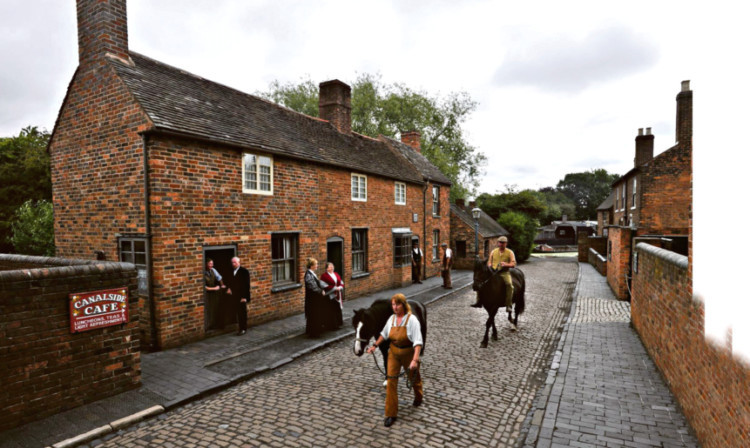
It might be the last place you’d think of for a short break but Birmingham, the UK’s second city, has a few surprises up its sleeve.
The city can actually be a great base for a journey back into the heritage of the industrial revolution.
The main reason I went to Birmingham was to visit The Black Country Living Museum. This fabulous outdoor museum is well worth a visit to be immersed in nostalgia.
Visit sweetie shops, a pub, a schoolroom, chapel, fun fair, chippy, tailor, countless homes, a garage an entire village, in fact all as it was from the 1830s through to the 1940s.
Staff in period costume will tell you all about the era and you can potter round at your own speed, taking a tram, a canal boat or an old bus to get around the 26-acre site.
You can even don a safety helmet and go down a former working mine to learn about the appalling conditions pre-1850. It really is absolutely fascinating and I can’t imagine any Sunday Post reader not loving every minute of their visit there. I know I did.
This is the finest and largest open-air museum in the United Kingdom. Located in Dudley, a 25-minute drive from Birmingham, this is the heart of the Black Country a distinctive part of the UK because of the scale and intensity of the industrial might that was unleashed there in Victorian times.
It all began in the 1830s, creating the first industrial landscape anywhere in the world. Beneath the smoke and glare from blast furnaces and forges, Black Country innovation, entrepreneurial and manufacturing skill established the region’s supremacy for the making of wrought iron, structural ironwork, chain making, locks and keys, tube manufacture, trap making and much more which brought fame to Black Country towns across the world.
The idea of the museum was developed in the 1950s by the Borough Librarian in Dudley. It’s been open to the public for 34 years and welcomes 300,000 visitors through its gates each year.
In the city of Birmingham itself, the two highlights for me were the Jewellery Quarter and the revamped Cube district, centred on caf society, by the canals.
An estimated 40% of all UK jewellery originates from Birmingham. In its heyday 40,000 workers crammed into this area, producing jewellery for the world. Nowadays, 3,500 still work there and if you’re looking for some serious bling this is the place to go.
The Museum of the Jewellery Quarter is a little gem. When the proprietors of the Smith & Pepper jewellery manufacturing firm decided to retire in 1981, they ceased trading and locked the door, unaware they’d be leaving a time capsule for future generations. Tools were left strewn on benches, grubby overalls were hung on the coat hooks and dirty teacups were abandoned alongside jars of Marmite and jam.
In the 80 years before its closure little had changed with the working practices and equipment. Even the decor had more in common with early 20th Century trends than a thriving business in the early 1980s. Today the factory is a remarkable museum, which tells the story of the Jewellery Quarter and Birmingham’s jewellery and metalworking heritage. The guided tour takes about 45 minutes and shows you the back-breaking work that jewellery employees went through to produce their wares. It’s £5 well spent.
For art lovers, there’s the Birmingham Museum and Art Gallery, which hosts the largest collection of Pre-Raphaelites in the world, and The Barber Institute of Fine Arts home to classics like Degas and Magritte.
Shopping in Brum is not to be sniffed at, from designer-label heaven at swanky new mall The Mailbox, and the iconic Selfridges and Bullring, to local markets and quirky independent shops.
For the foodie crowd, Birmingham boasts more than 200 mouth-watering restaurants in the city centre, serving cuisine from 27 different countries. For some of the freshest, best Indian food in the world go to Asha’s, 12 Newhall Street (ashasrestaurants.com). Asha’s has branches in Dubai, Kuwait, Qatar, and Bahrain, making it the only international Indian restaurant in Birmingham. The quality is amazing and it’s excellent value.
Opus Restaurant at 54 Cornwall St (opusrestaurant.co.uk) use quality local produce to produce a modern British menu in an elegant setting. Their lunch menu is £12.50 for two courses.
Lastly, the hotel I stayed in has an excellent restaurant. Aalto is located in the stylish and comfortable Hotel La Tour on Albert Street (hotel-latour.co.uk, rooms from £79).
The brasserie-style restaurant produces English classics with a twist. Excellent steaks and don’t miss the knickerbocker glory!
The Le Petit Spa at Hotel Malmaison is a lovely sanctuary. Located at The Mailbox, their therapists are excellent, so if you fancy a massage, head here. After all the trailing round museums and shops, it was worth every penny.
Think about a trip to this interesting part of the UK but pack flat shoes for those cobbles!

Enjoy the convenience of having The Sunday Post delivered as a digital ePaper straight to your smartphone, tablet or computer.
Subscribe for only £5.49 a month and enjoy all the benefits of the printed paper as a digital replica.
Subscribe